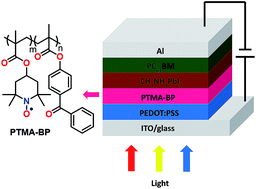Radical polymers as interfacial layers in inverted hybrid perovskite solar cells†
Abstract
We report high performance hybrid perovskite solar cells (PSCs) through the introduction of a radical polymer-based copolymer that contains a second moiety capable of undergoing crosslinking through simple exposure to ultraviolet (UV) light, poly(2,2,6,6-tetramethylpiperidinyloxy-4-yl methacrylate)-co-(4-benzoylphenyl methacrylate) (PTMA-BP). The PTMA-BP thin film engineered the surface of a poly(3,4-ethylenedioxythiophene):polystyrene sulfonate (PEDOT:PSS) hole extraction layer (HEL). Systematic investigations indicate that PTMA-BP can induce better band alignment between PEDOT:PSS and perovskite hybrids, reduce interfacial charge carrier recombination, and improve the crystallization of perovskite hybrids that are cast on the top of the HEL. As a result, the stable PSCs incorporated with PTMA-BP exhibit a 15% power conversion efficiency, which is more than a 15% enhancement compared to cells that lacked the PTMA-BP interfacial modifying layer.



 Please wait while we load your content...
Please wait while we load your content...